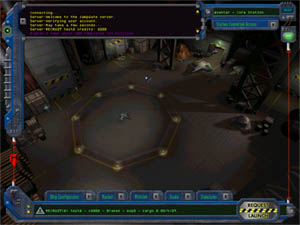|
This portion of the JOSSH device interface allows pilots to issue commands to the station's personnel. This module spans the bottom of the internal JOSSH device.

Along the top of the command module are five tabs: ship configurator, market, mission, trade and simulator. (Trade and simulator are displayed.) When clicked these tabs will bring up five different holographic screens that allow pilots to customize their ship, purchase goods, accept missions, trade with other pilots, and access the simulator.
In this picture a red flag labeled 'sim mode active' is displayed to the right of the tabs. This flag indicates whether a pilot is launching into the simulator or real space.
There is a large green text box below the command tabs. This is the pilot data bar, and displays various statistics on the current user. These statistics are rank and name, credits, experience, and cargo. (Cargo is displayed.) The most confusing statistics are the three numbers displayed as cargo. The first number is the amount of cargo that is currently loaded, the second is the maximum cargo that can be loaded, and the third is the amount of floor space that the docking crew will allow to be used. (This third number includes the ship's cargo.) Floor space can be used as temporary storage space, but will need to be cleared before a pilot can launch.
To the right of the pilot data bar is the 'request launch' button. By clicking this button a pilot will be propelled away from the safety of the station and into space. This button will occasionally be covered while tasks are being preformed, and a pilot will not be able to launch during that time.
|



